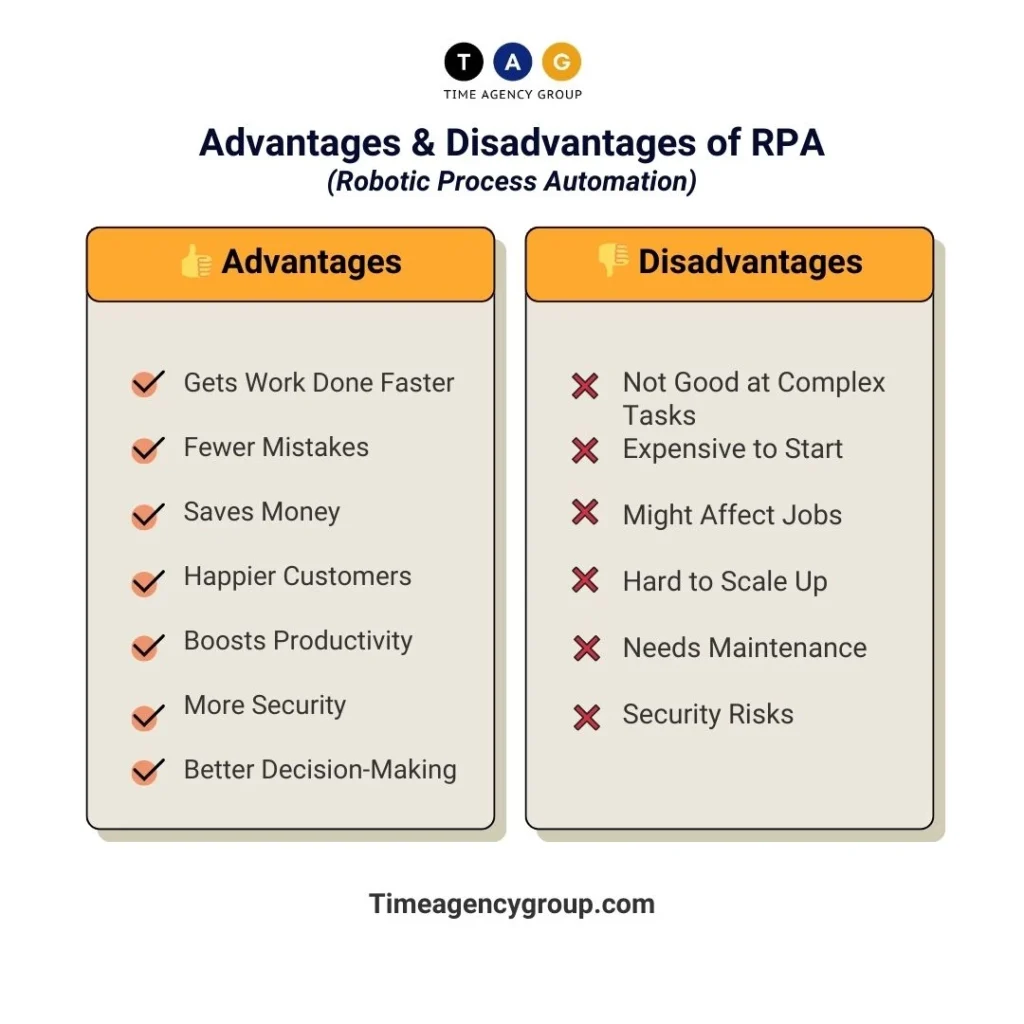Software robotics, called Robotic Process Automation (RPA), is shifting how regular tasks in business are managed. They help by doing these tasks, allowing companies to save time, cut mistakes, and enhance effectiveness. RPA has many plus points, like reduced costs, and it boosts productivity. But there are also hurdles. For instance, there are costs linked to kicking it off, and it might influence jobs. It’s key to grasp the good and bad of RPA for businesses looking at this tech. We’re going to delve into what RPA is, its main advantages, and boundaries, including other things in this blog.
What do you understand by robotic process automation?
Robotic process automation aids in using certain technologies to automate dull, repetitive, standard tasks, leading to more productivity and worth with less investment. In essence, a computer program, or ‘software bot,’ can grasp and interpret applications for processes that handle data, carry out transactions, initiate replies, and communicate with other digital systems within the field.
What are the advantages of robotic process automation?
Robotic Process Automation (RPA) has become a game-changer for businesses looking to improve efficiency and streamline their operations. Understanding the advantages of RPA can help organizations leverage it to save time, cut costs, and achieve greater scalability in their processes.
● Be More Productive: RPA bots get admin work done fast—hours instead of days or weeks. They’re not job stealers, but digital helpers, making workers and their companies better at getting stuff done.
● Be Accurate: When bots do jobs that people often goof up, like typing in data, everything gets better. You can pick robots that work alone or ones that need a human to set them off. This is great for safeguarding important data or when dealing with customers.
● Grow Your Business: Using bots can boost your work capacity, and demand for your super quality work may go up too. By following RPA advice, you can smooth out your work routine, linking teams and people.
● Keep Customers Happy: When customers get top-notch goods or services, they feel good about your brand. One wrong move can turn them off. But if they get quick, quality responses, transactions, goods, or services, they’ll probably stay with you.
● Keep Teams Happy: Using RPA frees your team to focus on big-picture tasks, learn to use automation tech, build their resumes, and find new ways automation can better the company. Rebecca Williams, from Pilot Company, says, “Our new designs are made with IADA in mind. We’re not asking ‘why automate,’ but ‘why not?’ and ‘how can it make our team better?’”
● Use Resources Wisely: Using bots in place of people for repeating tasks cuts down on mistakes, letting businesses save cash and manpower for important work. Plus, bots can do more work faster, speeding up delivery.
● Communicate Better: RPA tools can automate updates and tracking to make staff communication simpler. They can quickly and precisely carry out business operations. and pull together info from lots of systems, which then turns into handy insights to help integrate processes.
● Save Money: Bots work round-the-clock, doing manual jobs quicker and better, cutting down on expensive fixes, and giving humans more time for valuable work.
● Be Safe: Digital safety and data privacy are crucial these days. Bots can help shield against harmful threats by reducing the human touch on important data. Bots can guard against data leaks and unauthorized log-ins, keeping your business safe.
● Analyze Stuff With RPA: Businesses get precise data from lots of sources, making it easier to check whether their automated processes are meeting business goals. For instance, they can pull up work volume, errors, cycle times, and exceptions. RPA has other pluses too. It can boost returns on investment and help companies be flexible and compliant in line with rules and guidelines.
What are the disadvantages of robotic process automation?
While robotic process automation (RPA) offers numerous benefits like efficiency and cost savings, it is not without its challenges. Understanding these disadvantages is crucial for organizations to make informed decisions and effectively address potential limitations in their automation strategies.
● Dealing with tricky tasks: While RPA is great at managing simple, rule-based jobs, it can struggle with more complicated ones that don’t follow a set pattern. People, with their knack for analysis and decision-making, still rule in these areas.
● Cost considerations: Buying RPA software is just one cost. Companies must also think about costs tied to training, integrating systems, and getting the software up and running. These expenses can pile up, making the early period of using RPA costly.
● Growth issues: RPA can offer flexibility, but some tools may have issues growing, particularly when dealing with older systems. As companies increase in size, this can cause operational hiccups.
● Employment effects: The bot boom can cause worry about job loss. But it’s key to remember that while bots can do certain jobs, they can’t replace the human touch or our ability to solve problems or think creatively.
● Software risks: Relying too much on RPA can cause problems. Bots do a good job, but they can struggle when software updates or unexpected changes in user interfaces happen, which may disrupt operations.
● Security hurdles: Because RPA bots work across different platforms, they need broad access permissions. This much access can sometimes lead to security risks, which companies need to actively manage. Facing these challenges might seem scary, but with a correct plan and guidance, it’s doable. Redwood has solutions like digital business task automation and sophisticated IT automation processes, helping companies easily integrate RPA and manage its challenges.
Benefits of Robotic Process Automation
RPA enables your company to automate processes and tasks, saving time and bypassing common human errors. This technique involves training bots to carry out human tasks. They can do simple things like click and type across applications but can also handle more challenging tasks. By automating various tasks such as transferring information, updating customer records, data entry, managing stock, and other complex duties, your business benefits from RPA. Now, let’s look at the seven main advantages of robotic process automation:
● Time-efficient RPA comes in handy for those repetitive administrative duties we all know too well. With its speedy, robotic nature, it automates and handles these tasks in no time. This way, your business, and all your employees can spend more time tackling sensitive and intricate tasks. ROI Boost RPA tools raise productivity as they efficiently handle repetitive tasks. This efficiency adds positive effects to the ROI of your business.
● By enhancing various processes and collecting a lot of meaningful data over time, RPA can help your business better manage costs. Human error is out of the equation. Although everyone strives for perfection, fatigue, and human error are always lurking. But with RPA, accuracy is guaranteed; bots don’t tire and execute tasks correctly every time.
● Security upgrade RPA tools not only elevate your business’s cybersecurity but also help protect against threats. They limit human interactions with critical data, reducing the chance of potential data leaks and breaches. They work hard to keep your business secure from unauthorized access and automated account logouts.
● Compliance surge RPA solutions stick to the rules and guidelines, ensuring compliance and reliability for your business. Automation also eases auditing. Instead of multiple application audits, you can check everything from one place. This reduces compliance risks. RPA can be implemented for tasks such as contract workflow, form updates, and regulatory notifications and alerts. Automated business expansion The more you use RPA, the more your work gets automated.
● RPA helps your business adjust to increased demand and confidently meet targets. It’s useful for processing orders, managing invoices or inventory, and other production and service tasks. Happier employees RPA takes care of tedious tasks, freeing up employees to concentrate on priority business needs. As a result of fewer repetitive tasks, staff satisfaction goes up. This means your team can devote more time to strategic tasks like business planning, public relations, and brainstorming.
Conclusion
Think of Robotic Process Automation (RPA) as a reliable sidekick, streamlining tedious tasks and boosting efficiency. By automating repetitive processes, businesses can focus on higher-value initiatives. The advantages? Increased productivity, fewer errors, and significant cost savings—benefits that span various industries. However, RPA isn’t without challenges; high implementation costs and employee resistance can pose obstacles. Yet, when leveraged strategically, particularly in RPA recruitment, it can enhance operational growth and innovation. Understanding RPA’s capabilities and limitations empowers businesses to integrate it effectively, paving the way for a smarter and more efficient future.
FAQs
What is robotic process automation?
RPA uses software robots to perform many repetitive, high-volume tasks in a job setting.
What does RPA entail?
Understanding the Key Three Types of RPA, RPA comes in three types primarily: attended automation, unattended automation, and a mix of the two known as hybrid automation.
Infographic







